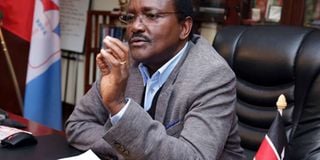How Wiper exit is paving the way for Raila in 2022 elections

What you need to know:
- The exits would also mean that the clause in the 2017 Nasa power-sharing agreement will now come alive.
- The clause gave Mr Odinga a free hand to run for president again in 2022 if the Nasa pact is now renewed.
Plans by Wiper Party to exit the National Super Alliance (Nasa) has opened a window for Orange Democratic Movement (ODM) leader Raila Odinga to renege on a pact that required him to back any of the three principals in the 2022 presidential poll.
During its National Executive Committee (NEC) meeting on Tuesday, the Kalonzo Musyoka-led party described Nasa as dysfunctional, and announced its plans to formally exit the coalition to join ranks with President Uhuru Kenyatta’s Jubilee Party, Baringo senator Gideon Moi’s Kanu and former Bomet governor Isaac Ruto’s Chama Cha Mashinani (CCM).
“We are now fully ready to leave Nasa and join Jubilee. We are going to negotiate our space in Jubilee and if it means losing some positions that were given to us by virtue of being in Nasa to get others by virtue of being in Jubilee, then so be it,” Wiper Secretary-General Judith Sijeny told the Nation Wednesday.
DISSOLVE NASA
The move by Wiper to activate the exit clause in its pact with Nasa, coupled with the CCM post-poll pact with Jubilee, now means Nasa is just one party shy of being deemed dissolved.
The Nasa pre-election agreement says the coalition will be deemed to have been dissolved if at least three parties exit.
The exits would also mean that the clause in the 2017 Nasa power-sharing agreement, which gave Mr Odinga a free hand to run for president again in 2022 if the Nasa pact is now renewed, will now come alive.
“In the event of the renewal of the coalition agreement for a further term of five years, the coalition’s presidential candidate in the August 2017 elections shall not be eligible for nomination as a presidential candidate,” the coalition agreement says in Article 10 (a) marked as an addendum.
Mr Musyoka, Amani National Congress leader Musalia Mudavadi and Ford-Kenya’s Moses Wetang’ula were all waiting to benefit from the clause in the 2022 elections.
‘PEOPLE’S PRESIDENT’
But following the January 30, 2018 swearing-in of Mr Odinga as the “people’s president” – an event the three leaders skipped – followed by the March 2018 Handshake between President Kenyatta and Mr Odinga, an event the three principals said they were not informed about, Nasa’s death was more or less confirmed.
“Nasa died on January 30, 2018 and we have said so repeatedly,” ODM Secretary-General Edwin Sifuna told the Nation yesterday.
“Each party is free to chart its future in the best interest of its members.”
ANC Secretary-General Barrack Muluka said even with all its challenges, Nasa still exists on paper, recognised by the Registrar of Political Parties and the two Houses of Parliament as a coalition. “In practice, however, Nasa died,” Mr Muluka said. “The last time Nasa principals met to discuss coalition affairs was Monday, March 11, 2018, just two days after the Handshake. There have been no meetings of the other Nasa organs.”
SPECIAL PURPOSE VEHICLE
Careful to state that his was a personal opinion, Mr Muluka said “this thing (Nasa) is dead and people should let it go”, arguing that Nasa was a special purpose vehicle aimed at the presidential seat “since we had cases where Nasa parties fielded different candidates for the same seats in the same electoral areas”.
“Politicians are, however, essentially selfish animals that live for the convenience of the moment. It should, therefore, not surprise me that as we move to 2022, the realities of the moment might bring the principals together again to re-energise Nasa,” Mr Muluka said.
In the 2017 pre-election agreement seen by the Nation, Mr Odinga’s ODM agreed to share equally among the Nasa parties, funds “attributed to the presidential vote”.
ODM and President Uhuru Kenyatta’s Jubilee Party are the only parties in Kenya that are eligible for the fund – 0.3 per cent of national revenue collected last year – for attaining the required threshold to get a share of taxpayers’ funds.
The law requires qualifying parties to have garnered at least three per cent of the total number of votes in the preceding general election.
PARTY FUNDS
“Funds due to the party from which the coalition presidential candidate has been chosen attributed to the presidential vote shall be shared equally among the coalition parties,” the Nasa coalition said in its power-sharing agreement signed on February 22, 2017, seen by the Nation.
Among the qualifying parties, the fund is divided 80 per cent proportionately based on the total number of votes in the previous election, 15 per cent based on the number of candidates of the party from special interest groups, with five per cent going to the Registrar of Political Parties to administer the fund.
“There are monies owed to the other parties based on this agreement and the coalition,” Mr Muluka said Wednesday.
The subject of the state of Nasa had also been broached by Mr Odinga’s deputy and Kakamega governor Wycliffe Oparanya who, like Mr Sifuna, argued that the coalition was dead and the parties should move on to other pacts.
“You cannot exist as a party just for the sake of it. The fact that we want to get power as ODM, we must look at options that will make us get power, because Nasa is long dead. We don’t want to repeat past mistakes.”





